I can remember clearly when the first McDonald’s restaurant opened near where I grew up in Mount Clemens, Michigan. To be honest, I wasn’t too excited about this interloper because we had our own “Golden Point” hamburger drive-in. But eventually, Mickey Dee’s won out, and the “Point” vanished into fond memories.

Over the years McDonald’s finally became my hamburger place of choice. I remember that I could get five hamburgers, two orders of fries, and two large Cokes for $1.83. But that was back in the late 1960s, and McDonald’s is much different today. Back then you’d walked up to a window that was located in the front of the building, ordered your food, which was waiting lined up in rows behind the server. The famous French fries were cut from whole potatoes right there in the restaurant, the milkshakes were hand-made with real ice cream and blended with a large mixer, and you ate in your car. Also, all the servers were young men.
We all have our stories to tell about our trips to McDonald’s; but what’s the history of this great American iconic restaurant chain? Personally, I had no idea how this place with its golden arches came about until I read Ray Kroc’s autobiography, “Grinding it Out.” What I learned from his book is that Kroc really wasn’t the originator of McDonald’s, but rather the marketer and developer of what it’s become today. In his book Kroc credits two brothers in San Bernardino California for creating the process and providing its name.
While visiting Palm Springs California a few years ago, I learned that there was a museum on the site of the original McDonald’s restaurant in San Bernardino. So I decided to drive over and see where it all had started. But before I tell you about this museum, let me present some of the convoluted history of this worldwide American icon and how it came to be.
This is an update of my 2023 post
It all began with Dick and Mac, the McDonald brothers
The history of McDonald’s Restaurants, as with most successful enterprises, followed a long and whining course. McDonald’s very roots began with two California transplants from Manchester New Hampshire, Richard “Dick” and Maurice “Mac” McDonald, who went west to chase their own American dream.
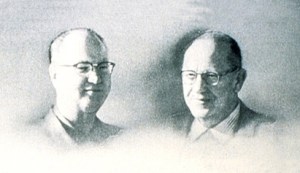
Photo from Wikipedia
The brothers moved to southern California to start their careers in the growing entertainment industry in the 1930s. After less than successful attempts in entertainment, they then decided to try their hand in the restaurant business. The brothers opened a Hot Dog stand in the small California town of Monrovia, which they named the “Airdrome,” after the small nearby airport, the “Foothill Flying Field.” They constructed their stand from borrowed lumber in an octagon shape, building it on the famous old Route 66. Their small stand was successful enough for them to move their parents out to California and open two additional stands.
However, the McDonald’s story really began in 1940, when the brothers decided to move their restaurant to the City of San Bernardino, about fifty miles to the east. The reason for this move has two different variations, depending on the source. One source says that the brothers moved because their customer base in Monrovia was primarily from those that attended the town’s local racetrack. This source says that when the racetrack season ended, so did the hot dog stand’s business. The other reason given is that San Bernardino was a much larger city with more potential. Whatever the reason, it was with this move that the story of McDonald’s really began to take shape.
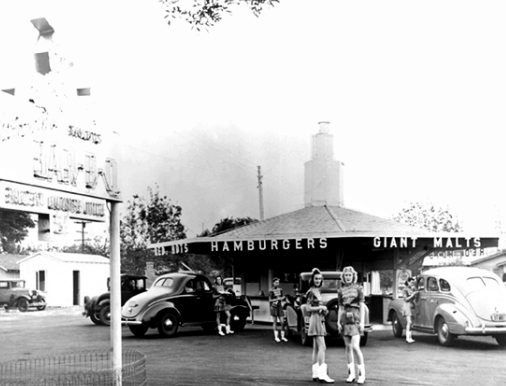
Photo Pinterest
When the brothers made the move to San Bernardino they didn’t just relocate their business, they moved the entire building as well. Cutting their octagon stand into two pieces they trucked them to a small piece of land at the corner of 14th and E Street (also on the old Route 66) and reassembled them. Now at the new location, the brothers also decided to expand their new restaurant’s menu to adding Bar-B-Que items. In 1940, they opened their new restaurant as, McDonald’s Barbecue, after their family.
Since they were making changes, they also embraced the new and popular drive-in concept, complete with young female car hops. This new restaurant was very, very successful for the brothers. But there were issues: their expanded menu was costly and time-consuming to prepare, and the carhops were drawing unruly teenage males that kept families away. Because of its success, it came as a big surprise to the community when just after eight years the brothers closed the restaurant in early 1948 to again reinvent themselves.
Richard “Dick” McDonald: the Henry Ford of fast food

Photo from the internet.
In their reevaluations the brothers took an inventory of what menu items were the biggest sellers; they found that hamburgers and French fries topped the list, so they decided to limit the new menu to just those items, along with soft drinks and milkshakes. They solved the car-hop issue by discontinuing them, and they also decided to just hire male workers. The brothers still wanted a drive-in type restaurant; only it had to be new and unique and serve the food faster than traditional restaurants and drive-ins.
It was Dick, with his engineering background, who designed the kitchen to maximize the speed, efficiency, and output of the food preparation while still keeping the food quality high. Dick even invented a utensil, based on a candy confectioner’s cone, to precisely squirt out the right amount of condiments, and also a mechanized hamburger press to make the patties.
To speed up the making of milkshakes, they purchased eight Mulitimixer blenders (more on this later) that could turn out five shakes at a time. The principals of Dicks design were basically a food assembly line, similar to what Henry Ford used for making his automobiles. Dick named his new process the “Speedee Service System.”
Another byproduct of their faster food preparation and a limited menu is that it allowed the brothers to reduce the prices of their food: hamburgers were 15 cents, French fries were 10 cents, and a creamy milkshake was only 20 cents. This was great for budget-conscious families.
On December 12, 1948, Mac and Dick cut the ribbon on their new “Speedee Service” McDonald’s. However, their “new” concept for a drive-in restaurant didn’t go over well at first; the young customers still came looking for the car-hops. But soon truckers, construction workers, taxi cab drivers, and families traveling along Route 66 discovered this restaurant where they could get a good meal fast and at a low price. It wasn’t long before the McDonald’s parking lot was jammed, with long lines of customers standing at the counter to order.
The birth of the “Fast Food” industry
With its ever-increasing crowds and popularity, the restaurant began drawing more than just those looking for a great meal deal. Other restaurateurs came, taking advantage of Mac and Dick’s openness, and copied this new fast food process for their own restaurants, one of those being Taco Bell founder Glen Bell. Realizing that they could make money selling Dick’s process, the brothers began limited franchising of the Speedee Serve system in 1953, for a fee of $950. For that fee the purchaser simply got a manual that outlined the system.
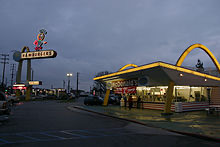
Photo from Wikipedia
As the requests began to mount from those wishing to use the Speedee Service System, Dick thought it would be a good time to standardize the look of the restaurant’s building. Dick’s idea was that the building itself would be an eye-catching sign to attract customers. With a rough drawn idea, the brothers began shopping for an architect that could make Dick’s idea a reality. Finally, they selected California architect Stanley Meston, along with his assistant Charles Fish. The two took the rough drawing and created what would become the most recognizable business symbol in the world, the “Golden Arches.”
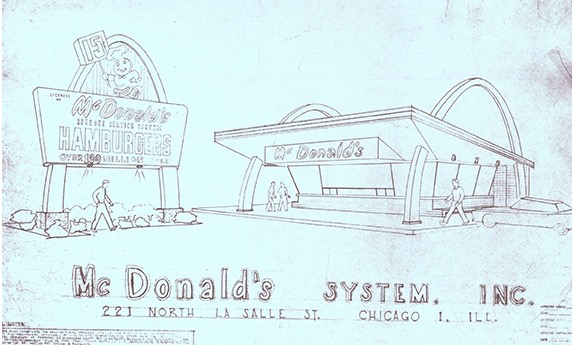
Photo from Pinterest
The first franchisee to use this new building design was Neil Fox for his restaurant in Phoenix Arizona. Another first that Fox brought to McDonald’s history was that he was the first, other than the original, to use the name “McDonald’s” for his restaurant. Up until then, the McDonald brothers hadn’t made the name part of the franchise. When the brothers asked Fox why he used the name, they thought the name meant nothing outside of San Bernardino, Fox answered that he believed the name was “lucky.” From then on the name, McDonald’s became part of the franchise. Over the next year, the brothers were successful in selling a few franchises. With that money coming in, and the continued success of their own restaurant, they were quite content.
But that was about to change, in 1954 the success of McDonald’s was having caught the attention of someone else, a 52-year-old Chicago salesman looking for his big break named Ray Kroc.
Ray Kroc
Although in his autobiography “Grinding it Out,” Ray Kroc doesn’t mention that the McDonald brothers already had a number of franchises in existence by the time he arrived in 1954. Or that the Carnation Corporation had offered the brothers a partnership to expand McDonald’s nationwide before him. But it would be Ray Kroc who would forever change the lives of Mac and Dick McDonald and be the one that would begin to make McDonald’s restaurants what we know today.
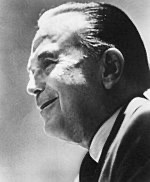
Photo from Wikipedia
Raymond Albert “Ray” Kroc was a traveling salesman from Chicago who was constantly looking for his “Big break.” Kroc had been a real estate salesman, a paper cup salesman, and sometimes a piano player. Kroc was 52 years old and the sales representative for Prince Castle’s “Multimixer.” The Multimixer was a heavy-duty commercial blender that could handle five malts or shakes at one time. So large was this unit that even the largest soda shops only needed one to do the job. So it was a big surprise for Kroc when a small drive-in restaurant in San Bernardino California had ordered eight units. This got Ray’s attention, and he decided to personally go to California and check out what this “McDonald’s” was doing that required eight of his mixers.
At first, Kroc observed what was happening from across the street, where he was amazed at how big the crowds were and how quickly they were being served. Finally, he went over and introduced himself to the brothers. Dick and Mac were excited to meet the salesman for their mixers and as always proudly and openly showed him the efficiency of their Speedee Service System.
Ray Kroc was able to do what even Carnation couldn’t do, and that was to get the brothers to partner with him. The original agreement had Dick and Mac owning the west coast franchises, while Kroc would be the franchise agent east of the Mississippi River. In this agreement, Kroc would pay the brothers for the rights to use their concept which included: the Speedee Service System, the McDonald’s name, and the restaurant building design. Kroc would get 1.5 percent of the gross sales, for which the brothers received .05 percent.
Soon Kroc’s ambition and drive caused deep conflicts between him and the brothers. Mac and Dick were very happy to just operate their small restaurant, and they didn’t like the fast expansions and changes Kroc wanted to make. Finally, when Mac and Dick refused to answer his letters, a frustrated Ray Kroc forced the brothers to sell. In 1961 Kroc bought out their interests and the entire concept for 2.7 million dollars.
This dissolving of the partnership wasn’t very pleasant. Kroc found that the original restaurant, and the land it sat on, weren’t part of the sale. And although he didn’t own the restaurant, Kroc did own the name, forcing the brothers to change the name of their McDonald’s to the Big M. Then adding insult to injury, Kroc built one of his “McDonald’s just down the street from the brothers. Dick and Mac couldn’t compete with this new McDonald’s and sadly closed their restaurant in 1962. The brothers never opened another restaurant or any other business afterward.
Mac and Dick: Post McDonald’s
Maurice “Mac” McDonald
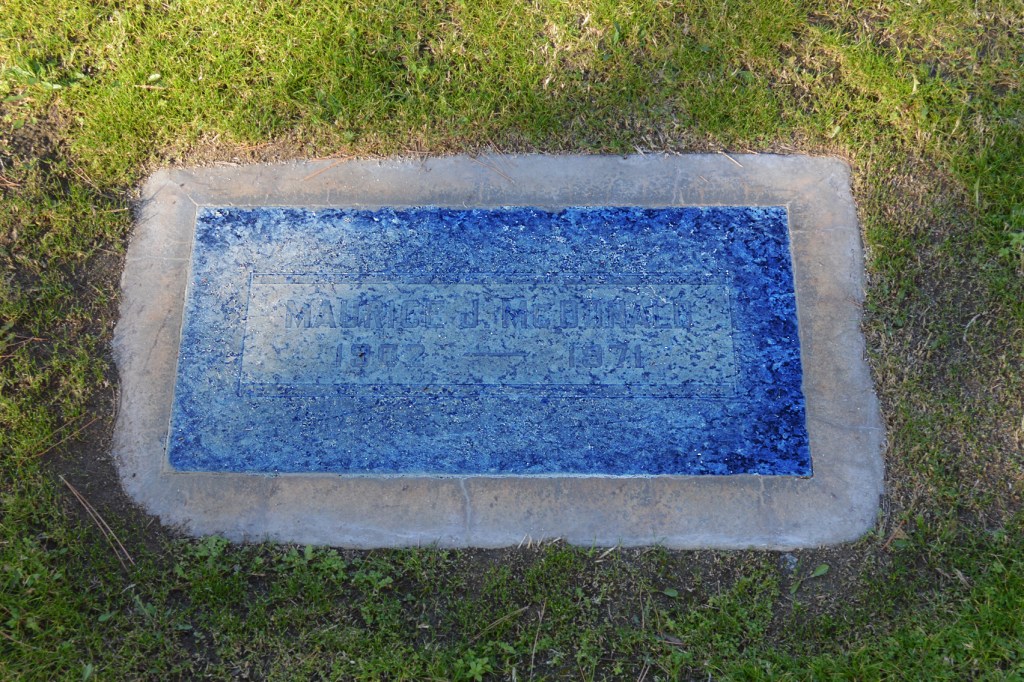
Photo by author
On December 11, 1971, Maurice “Mac” McDonald died of a heart attack, just nine years after the sale. The family said he never recovered from the stress of the battle that he and his brother had with Kroc. Mac is buried at Desert Memorial Park in Cathedral City California. Richard “Dick” McDonald
Richard “Dick” McDonald
Dick returned to Manchester New Hampshire. After many years Dick finally reestablished connections with the McDonald’s corporation. On November 30, 1984, Dick was served a ceremonial 50 billionth McDonald’s hamburger by Ed Rensi, then president of McDonald’s USA. On July 14, 1998, Richard McDonald passed away in a nursing home in Manchester and is buried at Mount Calvary Cemetery, also in Manchester.
Raymond Albert “Ray” Kroc
Ray Kroc, the brother’s original partner, died on January 14, 1984, just months before Dick McDonald was served the 50 billionth McDonald’s hamburger. Upon his death in 1984 Kroc’s worth was $600 million. Raymond “Ray” Kroc is buried at El Camino Memorial Park in Sorrento Valley San Diego California.
I thought it was an interesting fact in the McDonald’s story that Ray Kroc paid $2.7 million dollars to the brothers for the rights to McDonald’s. When Kroc’s wife Joan passed away in 2003, she left the remainder of their estate to a number of charities. The total was $2.7 billion dollars.
Where it all began: Fast Food Restaurants
When you visit this historic site, and tour the McDonald’s museum, remember that not only did Dick and Mac start what would become the largest restaurant chain in the world there; but it’s also where they helped to create the fast food industry.
The original McDonald’s Restaurant site and museum is located at 1398 North East Street, San Bernardino California.
The McDonald’s original site museum
For eleven years the original building sat empty, falling into disrepair. In 1972 the building was torn down, and replaced with a music store owned by the San Bernardino Civic Light Opera Association. When the original sign was also to be torn down a concerned neighbor, seeing a bit of history would be lost, mounted a campaign that saved it. It’s this sign that will help you to find the museum.

Photo by author
When the property went into foreclosure in 1998, it was purchased by Albert Okura, a modern fast-food acolyte and founder of the Juan Pollo rotisserie chicken restaurant chain. The building now holds both the unofficial McDonald’s museum and the corporate offices of Okura’s Juan Pollo restaurant chain.
Okura says that it was McDonald’s that caused him to choose a career in fast food. So, when the opportunity to purchase the site came about, he jumped on it. Besides his love for McDonald’s, Okura knows that this site is a valuable piece of American restaurant history and shouldn’t be lost.

Photo by author
Okura opened his “unofficial” McDonald’s museum on December 12, 1998, the 50th Anniversary of when Dick and Mac opened the original McDonald’s. The museum not only features items from the early years of McDonald’s, including items used by the brothers in the original restaurant but also more contemporary items. There is also a host of McDonald’s packaging, advertising, and promotional items to see. If you have anything that’s McDonald’s in your possession and can part with them, they do accept donations; they’d really love to have a Ronald McDonald costume.
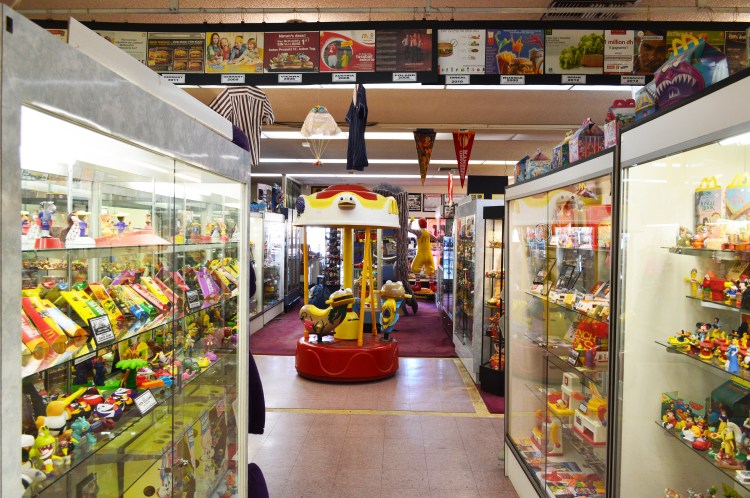
Photo by author
This museum is called “unofficial” because it’s not sanctioned by the McDonald’s Corporation. For years McDonald’s didn’t recognize this as the site of the “original” restaurant. They consider Ray Kroc’s first McDonald’s in Des Plaines, Illinois as being location #1. They even ignored all the other franchise locations sold by the McDonald brothers before Kroc entered the picture, like the one in Downy California that opened in 1953. That location is still in existence, and its building remains almost unchanged from the time it opened.
Happily, the McDonald’s Corporation has recently been taking a more historical stance on the company’s beginnings. One of the biggest changes is at the company’s annual “Founders Day” celebration. At first, they only named Ray Kroc as the founder. But now they’ve also added Dick and Mac McDonald as founders.
It’s where it all began: Fast Food Restaurants

Photo by author
When you visit this historic site, and tour the McDonald’s museum, remember that it’s not only where Dick and Mac started their small hamburger drive-in in 1948, which would become the largest restaurant chain in the world there, but also where they helped to create the fast food industry.
The original McDonald’s Restaurant site and museum is located at 1398 North East Street, San Bernardino California.
Sources:
Buck, Fielding. “Celebrate the birth of fast food at the McDonald’s museum in San Bernardino .” The Sun, MediaNews Group, 7 Dec. 2018, http://www.sbsun.com/2018/12/07/celebrate-the-birth-of-fast-food-at-the-mcdonalds-museum-in-san-bernardino.
“Desert Memorial Park.” Wikipedia, Wikipedia, 12 Jan. 2020, en.m.wikipedia.org/wiki/Desert_Memorial_Park.
“Famous Memorials in Desert Memorial Park.” Find A Grave Cemeteries, Find A Grave, http://www.findagrave.com/cemetery/188858/famous-memorials?page=2#sr-1414. Accessed 16 Sept. 2019.
Josh. “The Original McDonald’s: A Museum in San Bernardino.” California Through My Lens, Josh, 23 Aug. 2019, californiathroughmylens.com/original-mcdonalds-museum-san-bernardino.
“Maurice James “Mac” McDonald.” Find A Grave Memorials , Find A Grave, http://www.findagrave.com/memorial/14303576/maurice-james-mcdonald. Accessed 12 Sept. 2019.
“McDonald’s .” Wikipedia, Wikipedia, 29 Jan. 2020, en.m.wikipedia.org/wiki/McDonald%27s.
McDonald’s. “History.” McDonald’s, McDonald’s Corp., corporate.mcdonalds.com/corpmcd/about-us/history.htm. Accessed 15 Jan. 2020.
Napoli , Lisa. “The Story of How McDonald’s First Git Its Start.” Smithsonian , Smithsonian Magazine, 1 Nov. 2016, http://www.smithsonianmag.com/history/story-how-mcdonalds-first-got-its-start-180960931/.
“Original McDonald’s Site Museum.” RoadsideAmerica.com, RoadsideAmerica.com, http://www.roadsideamerica.com/story/16857. Accessed 31 Jan. 2020.
“Ray Kroc.” Wikipedia, Wikipedia, 30 Jan. 2020, en.m.wikipedia.org/wiki/Ray_Kroc.
“Richard and Maurice McDonald.” Wikipedia, Wikipedia, 21 Jan. 2020, en.m.wikipedia.org/wiki/Richard_and_Maurice_McDonald.
Sterling Multi Products, Inc. “Soda Fountain Multimixer History.” Sterling Multi Products, Inc., Sterling MultiProducts, http://www.sterlingmulti.com/multimixer_history.htm. Accessed 18 Jan. 2020.
Wikipedia . “Oldest McDonald’s restaurant.” Wikipedia, Wikipedia, Dec. 2019, en.m.wikipedia.org/wiki/Oldest_McDonalds%27_restaurant.
Reblogged this on Ancien Hippie.
LikeLike
Great blog you have herre
LikeLike
Thank you so much
LikeLike